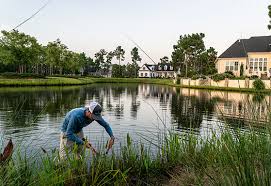Detention Pond
Intro
Detention ponds are an important part of stormwater management systems in many urban and suburban areas. These man-made basins are designed to collect and hold excess water from heavy rains or snowmelt, reducing the risk of flooding and erosion in surrounding areas. Detention ponds are a crucial component in protecting our communities from the negative effects of excess water, and proper maintenance is essential to ensure their effectiveness.
In this blog post, we will discuss the importance of detention pond maintenance and best management practices to keep these vital structures functioning properly. When implemented effectively, detention ponds can provide numerous benefits beyond basic flood control, including recreational opportunities (e.g. fishing, bird-watching), habitat creation, improved property values and aesthetics within urban or suburban landscapes.
Failure to properly maintain retention ponds can result in costly fines from local governments or environmental regulatory agencies. In some cases, violations can result in penalties ranging from several hundred dollars to thousands of dollars per day until the problem is resolved. In order to be effective at preventing flooding and controlling stormwater runoff, retention ponds must be properly designed with appropriate dimensions and inlet/outlet structures.
The function of a detention pond is to provide temporary storage for stormwater runoff, allowing sediment and pollutants to settle out of suspension before the water is slowly released into nearby streams or rivers. This helps improve water quality and prevents the downstream impacts of excess nutrients and pollutants.
Additionally, detention ponds also help recharge groundwater by allowing water to infiltrate into the soil over time. This can be particularly important in areas with limited water resources or during dry periods. Understanding the purpose of your retention pond is the first step in proper maintenance and management. It ensures that you can effectively monitor and address any issues that may arise, ultimately helping to protect your community and the environment.
Regular Inspection and Monitoring
Regular inspection and monitoring of your retention pond is crucial for maintaining its effectiveness and preventing potential issues. By regularly assessing the condition of your pond, you can identify and address any maintenance needs before they become major problems.
One important aspect of regular inspection is checking for any signs of erosion or damage to the
 pond’s banks or outlet structures. This can help prevent leaks and ensure proper drainage. It is also important to inspect the vegetation around the pond, as overgrown plants can obstruct water flow and cause drainage issues.
pond’s banks or outlet structures. This can help prevent leaks and ensure proper drainage. It is also important to inspect the vegetation around the pond, as overgrown plants can obstruct water flow and cause drainage issues.
In addition to visual inspections, regular monitoring of water levels and water quality is essential. Monitoring can help identify any changes in water clarity or nutrient levels, which can indicate potential pollution or nutrient runoff problems. Regular monitoring also allows you to track the effectiveness of any management practices you have implemented.
Pond Cleanliness and Waste Removal
Maintaining cleanliness and removing waste from your detention pond is essential for its proper function and effectiveness. Over time, debris such as leaves, twigs, and trash can accumulate in the pond, obstructing water flow and hindering its ability to effectively manage stormwater. Regularly removing this waste not only helps prevent drainage issues but also improves the overall aesthetic appeal of the pond.
 To ensure proper pond cleanliness and waste removal, it is recommended to schedule regular cleanings and inspections. This may involve using rakes or skimmers to remove surface debris, as well as dredging or vacuuming to remove sediment
To ensure proper pond cleanliness and waste removal, it is recommended to schedule regular cleanings and inspections. This may involve using rakes or skimmers to remove surface debris, as well as dredging or vacuuming to remove sediment
buildup at the bottom of the pond. It’s important to follow any applicable local regulations or guidelines regarding waste disposal, as certain materials may need to be disposed of in a specific manner.
In addition to physical debris, it’s crucial to address any chemical or biological waste in the detention pond. This may involve regularly testing the water for pollutants or excessive nutrient levels and implementing appropriate measures to mitigate these issues. By maintaining cleanliness and removing waste from your detention pond, you can ensure its long-term functionality and effectiveness in managing stormwater, protecting both your community and the environment.


